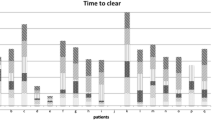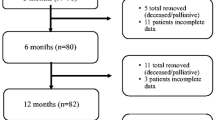Abstract
With no long-term data available in published research to date, this study presents details of the swallowing outcomes as well as barriers to and facilitators of oral intake and weight maintenance at 2 years after altered fractionation radiotherapy with concomitant boost (AFRT-CB). Twelve patients with T1–T3 oropharyngeal cancer who received AFRT-CB were assessed at baseline, 6 months, and 2 years post-treatment for levels of dysphagia and salivary toxicity, food and fluid tolerance, functional swallowing outcomes, patient-reported function, and weight. At 2 years, participants were also interviewed to explore barriers and facilitators of oral intake. Outcomes were significantly worse at 2 years when compared to baseline for late toxicity, functional swallowing, and patient-rated physical aspects of swallowing. Most patients (83%) tolerated a full diet pretreatment, but the rate fell to 42% (remainder tolerated soft diets) at 2 years. Multiple barriers to oral intake that impacted on activity and participation levels were identified. Participants lost 11 kg from baseline to 2 years, which was not regained between 6 months and 2 years. Global, social, and emotional domains of patient-reported function returned to pretreatment levels. At 2 years post AFRT-CB, worsening salivary and dysphagia toxicity, declining functional swallowing, and multiple reported ongoing barriers to oral intake had a negative impact on participants’ activity and participation levels relating to eating. These ongoing deficits contributed to significant deterioration in physical swallowing functioning determined by the MDADI. In contrast, patients perceived their broader functioning had improved at 2 years, suggesting long-term adjustment to ongoing swallowing deficits.



Similar content being viewed by others
References
Bourhis J, Overgaard J, Audry H, Ang K, Saunders M, Bernier J, Horiot J, Le Ma tre A, Pajak T, Poulsen M. Hyperfractionated or accelerated radiotherapy in head and neck cancer: a meta-analysis. Lancet. 2006;368:843–54.
Fu KK, Pajak TF, Trotti A, Jones CU, Spencer SA, Phillips TL, Garden AS, Ridge JA, Cooper JS, Ang KK. A Radiation Therapy Oncology Group (RTOG) phase III randomized study to compare hyperfractionation and two variants of accelerated fractionation to standard fractionation radiotherapy for head and neck squamous cell carcinomas: first report of RTOG 9003. Int J Radiat Oncol Biol Phys. 2000;48:7–16.
Rosenthal DI, Ang KK. Altered radiation therapy fractionation, chemoradiation, and patient selection for the treatment of head and neck squamous carcinoma. Semin Radiat Oncol. 2004;14:153–66.
Denham JW, Peters LJ, Johansen J, Poulsen M, Lamb DS, Hindley A, O’Brien PC, Spry NA, Penniment M, Krawitz H, Williamson S, Bear J, Tripcony L. Do acute mucosal reactions lead to consequential late reactions in patients with head and neck cancer? Radiother Oncol. 1999;52:157–64.
Dörr W, Hendry JH. Consequential late effects in normal tissues. Radiother Oncol. 2001;61:223–31.
Overgaard J, Hansen HS, Specht L, Overgaard M, Grau C, Andersen E, Bentzen J, Bastholt L, Hansen O, Johansen J. Five compared with six fractions per week of conventional radiotherapy of squamous-cell carcinoma of head and neck: DAHANCA 6&7 randomised controlled trial. Lancet. 2003;362:933–40.
Poulsen MG, Denham JW, Peters LJ, Lamb DS, Spry NA, Hindley A, Krawitz H, Hamilton C, Keller J, Tripcony L. A randomised trial of accelerated and conventional radiotherapy for stage III and IV squamous carcinoma of the head and neck: a Trans-Tasman Radiation Oncology Group Study. Radiother Oncol. 2001;60:113–22.
Saunders MI, Rojas AM, Parmar MK, Dische S. Mature results of a randomized trial of accelerated hyperfractionated versus conventional radiotherapy in head-and-neck cancer. Int J Radiat Oncol Biol Phys. 2010;77:3–8.
Fowler JF, Harari PM, Leborgne F, Leborgne JH. Acute radiation reactions in oral and pharyngeal mucosa: tolerable levels in altered fractionation schedules. Radiother Oncol. 2003;69:161–8.
Cartmill B, Cornwell P, Ward EC, Davidson W, Porceddu SV. A prospective investigation of swallowing, nutrition, and patient-rated functional impact following altered fractionation radiotherapy with concomitant boost for oropharyngeal cancer. Dysphagia. 2011;. doi:10.1007/s00455-001-9333-5.
Yu KH, Chua M, Vlantis AC, Kam MKM, Lee WY, Tsang RKY, Yuen HY, Hui EP, Chan ATC. Swallowing function after altered fractionation radiotherapy for head and neck carcinoma. J Hong Kong Coll Radiol. 2005;8:207–13.
Nguyen LM, Ang KK. Radiotherapy for cancer of the head and neck: altered fractionation regimens. Lancet Oncol. 2002;3:693–701.
Hammerlid E, Bjordal K, Ahlner-Elmqvist M, Jannert M, Kaasa S, Sullivan M, Westin T. Prospective, longitudinal quality-of-life study of patients with head and neck cancer: A feasibility study including the EORTC QLQ-C30. Otolaryngol Head Neck Surg. 1997;116:666–73.
Hammerlid E, Wirblad B, Sandin C, Mercke C, Edstrom S, Kaasa S, Sullivan M, Westin T. Malnutrition and food intake in relation to quality of life in head and neck cancer patients. Head Neck. 1998;20:540–8.
Hammerlid E, Persson LO, Sullivan M, Westin T. Quality-of-life effects of psychosocial intervention in patients with head and neck cancer. Otolaryngol Head Neck Surg. 1999;120:507–16.
de Graeff A, de Leeuw JRJ, Ros WJG, Hordijk GJ, Blijham GH, Winnubst JAM. A prospective study on quality of life of patients with cancer of the oral cavity or oropharynx treated with surgery with or without radiotherapy. Oral Oncol. 1999;35:27–32.
List MA, Siston A, Haraf D, Schumm P, Kies M, Stenson K, Vokes EE. Quality of life and performance in advanced head and neck cancer patients on concomitant chemoradiotherapy: a prospective examination. J Clin Oncol. 1999;17:1020–8.
Ringash J, Lockwood G, O’Sullivan B, Warde P, Bayley A, Cummings B, Kim J, Sellmann S, Waldron J. Hyperfractionated, accelerated radiotherapy for locally advanced head and neck cancer: quality of life in a prospective phase I/II trial. Radiother Oncol. 2008;87:181–7.
Bjordal K, Kaasa S. Psychological distress in head and neck cancer patients 7–11 years after curative treatment. Br J Cancer. 1995;71:592–7.
Gritz ER, Carmack CL, de Moor C, Coscarelli A, Schacherer CW, Meyers EG, Abemayor E. First year after head and neck cancer: quality of life. J Clin Oncol. 1999;17:352.
Langendijk JA, Doornaert P, Verdonck-de Leeuw IM, Leemans CR, Aaronson NK, Slotman BJ. Impact of late treatment-related toxicity on quality of life among patients with head and neck cancer treated with radiotherapy. J Clin Oncol. 2008;26:3770–6.
Nguyen NP, Vos P, Karlsson U, Nguyen P, Dutta S, Lemanski C, Ludin A, Rose S, Nguyen LM, Ward H, Huang S, Sallah S. Quality of life following chemoradiation and postoperative radiation for locally advanced head and neck cancer. ORL J Otorhinolaryngol Relat Spec. 2007;69:271–6.
Trotti A, Colevas AD, Setser A, Rusch V, Jaques D, Budach V, Langer C, Murphy B, Cumberlin R, Coleman CN. CTCAE v3.0: development of a comprehensive grading system for the adverse effects of cancer treatment. Semin Radiat Oncol. 2003;13:176–81.
Dietetics Association of Australia and The Speech Pathology Association of Australia Limited. Texture-modified foods and thickened fluids as used for individuals with dysphagia: Australian standardized labels and definitions. Nutr Diet. 2007;64:S53–76.
Ward EC, Conroy AL. Validity, reliability, and responsivity of the Royal Brisbane Hospital Outcome Measure for swallowing. Asia Pac J Speech Lang Hear. 1999;4:109–29.
Cella DF, Tulsky DS, Gray G, Sarafian B, Linn E, Bonomi A, Silberman M, Yellen SB, Winicour P, Brannon J, Eckberg K, Lloyd S, Purl S, Blendowski C, Goodman M, Barnicle M, Stewart I, McHale M, Bonomi P. The functional assessment of cancer therapy scale: development and validation of the general measure. J Clin Oncol. 1993;11:570–9.
Chen AY, Frankowshi R, Bishop-Leone J, Hebert T, Leyk S, Lewin J, Goepfert H. The development and validation of a dysphagia-specific quality-of-life questionnaire for patients with head and neck cancer: The M. D. Anderson Dysphagia Inventory. Arch Otolaryngol Head Neck Surg. 2001;127:870–6.
D’Antonio LL, Zimmerman GJ, Cella DF, Long SA. Quality of life and functional status measures in patients with head and neck cancer. Arch Otolaryngol Head Neck Surg. 1996;122:482–7.
Tschiesner U, Cieza A, Rogers SN, Piccirillo J, Funk G, Stucki G, Berghaus A. Developing core sets for patients with head and neck cancer based on the International Classification of Functioning, Disability and Health (ICF). Eur Arch Otorhinolaryngol. 2007;264:1215–22.
Tschiesner U, Rogers S, Dietz A, Yueh B, Cieza A. Development of ICF core sets for head and neck cancer. Head Neck. 2010;32:210–20.
Bleier BS, Levine MS, Mick R, Rubesin SE, Sack SZ, McKinney K, Mirza N. Dysphagia after chemoradiation: analysis by modified barium swallow. Ann Otol Rhinol Laryngol. 2007;116:837–41.
Lazarus CL. Effects of radiation therapy and voluntary maneuvers on swallow functioning in head and neck cancer patients. Clin Commun Disord. 1993;3:11–20.
Mekhail TM, Adelstein DJ, Rybicki LA, Larto MA, Saxton JP, Lavertu P. Enteral nutrition during the treatment of head and neck carcinoma. Cancer. 2001;91:1785–90.
Mittal BB, Pauloski BR, Haraf DJ, Pelzer HJ, Argiris A, Vokes EE, Rademaker A, Logemann JA. Swallowing dysfunction: Preventative and rehabilitation strategies in patients with head-and-neck cancers treated with surgery, radiotherapy, and chemotherapy: a critical review. Int J Radiat Oncol Biol Phys. 2003;57:1219–30.
Newman LA, Vieira F, Schwiezer V, Samant S, Murry T, Woodson G, Kumar P, Robbins KT. Eating and weight changes following chemoradiation therapy for advanced head and neck cancer. Arch Otolaryngol Head Neck Surg. 1998;124:589–92.
Harrison LB, Zelefsky MJ, Pfister DG, Carper E, Raben A, Kraus DH, Strong EW, Rao A, Thaler H, Polyak T. Detailed quality of life assessment in patients treated with primary radiotherapy for squamous cell cancer of the base of the tongue. Head Neck. 1997;19:169–75.
Rademaker A, Vonesh E, Logemann J, Pauloski B, Liu D, Lazarus C, Newman L, May A, MacCracken E, Gaziano J. Eating ability in head and neck cancer patients after treatment with chemoradiation: a 12-month follow-up study accounting for dropout. Head Neck. 2003;25:1034–41.
Schwartz DL, Hutcheson K, Barringer D, Tucker SL, Kies M, Holsinger FC, Ang KK, Morrison WH, Rosenthal DI, Garden AS. Candidate dosimetric predictors of long-term swallowing dysfunction after oropharyngeal intensity-modulated radiotherapy. Int J Radiat Oncol Biol Phys. 2010;78:1356–65.
Caudell JJ, Schaner PE, Meredith RF, Locher JL, Nabell LM, Carroll WR, Magnuson JS, Spencer SA, Bonner JA. Factors associated with long-term dysphagia after definitive radiotherapy for locally advanced head-and-neck cancer. Int J Radiat Oncol Biol Phys. 2009;73:410–5.
Maciejewski B, Skladowski K, Pilecki B, Taylor J, Withers R, Miszczyk L, Zajusz A, Suwinski R. Randomized clinical trial on accelerated 7 days per week fractionation in radiotherapy for head and neck cancer. Preliminary report on acute toxicity. Radiother Oncol. 1996;40:137–45.
Ku PK, Yuen EH, Cheung DM, Chan BY, Ahuja A, Leung SF, Tong MC, van Hasselt A. Early swallowing problems in a cohort of patients with nasopharyngeal carcinoma: symptomatology and videofluoroscopic findings. Laryngoscope. 2007;117:142–6.
Larsson M, Hedelin B, Johansson I, Athlin E. Eating problems and weight loss for patients with head and neck cancer: a chart review from diagnosis until one year after treatment. Cancer Nurs. 2005;28:425–35.
McQuestion M, Fitch M, Howell D. The changed meaning of food: Physical, social and emotional loss for patients having received radiation treatment for head and neck cancer. Eur J Oncol Nurs. 2011;15:145–51.
Semple CJ, Dunwoody L, Kernohan WG, McCaughan E, Sullivan K. Changes and challenges to patients’ lifestyle patterns following treatment for head and neck cancer. J Adv Nurs. 2008;63:85–93.
Wilson PR, Herman J, Chubon SJ. Eating strategies used by persons with head and neck cancer during and after radiotherapy. Cancer Nurs. 1991;14:98–104.
de Graeff A, de Leeuw JRJ, Ros WJG, Hordijk GJ, Blijham GH, Winnubst JAM. Long-term quality of life of patients with head and neck cancer. Laryngoscope. 2000;110:98–106.
Terrell JE, Ronis DL, Fowler KE, Bradford CR, Chepeha DB, Prince ME, Teknos TN, Wolf GT, Duffy SA. Clinical predictors of quality of life in patients with head and neck cancer. Arch Otolaryngol Head Neck Surg. 2004;130:401–8.
Weymuller EA Jr, Alsarraf R, Yueh B, Deleyiannis FWB, Coltrera MD. Analysis of the performance characteristics of the University of Washington Quality of Life instrument and its modification (UW-QOL-R). Arch Otolaryngol Head Neck Surg. 2001;127:489–93.
World Health Organisation. International classification of functioning, disability, and health: ICF. Geneva: World Health Organisation; 2001.
Acknowledgment
Funding for this research was obtained as PhD scholarships through the Cancer Council Queensland and Cancer Collaborative Group, Princess Alexandra Hospital.
Author information
Authors and Affiliations
Corresponding author
Rights and permissions
About this article
Cite this article
Cartmill, B., Cornwell, P., Ward, E. et al. Long-term Functional Outcomes and Patient Perspective Following Altered Fractionation Radiotherapy with Concomitant Boost for Oropharyngeal Cancer. Dysphagia 27, 481–490 (2012). https://doi.org/10.1007/s00455-012-9394-0
Received:
Accepted:
Published:
Issue Date:
DOI: https://doi.org/10.1007/s00455-012-9394-0




